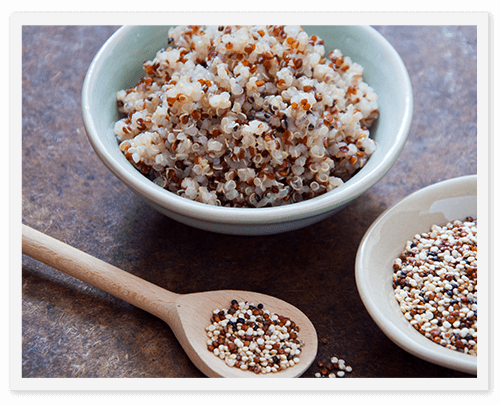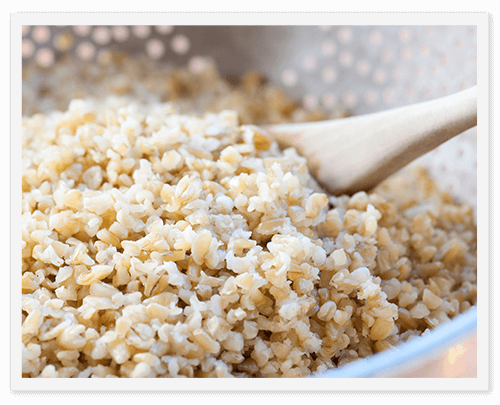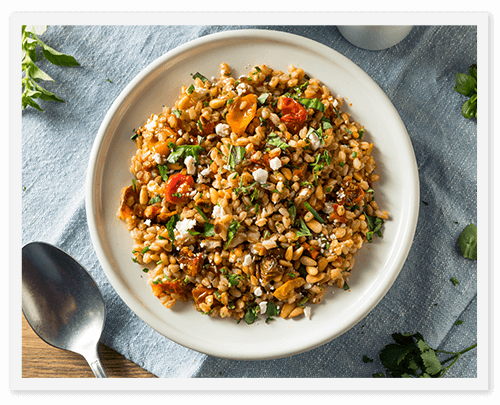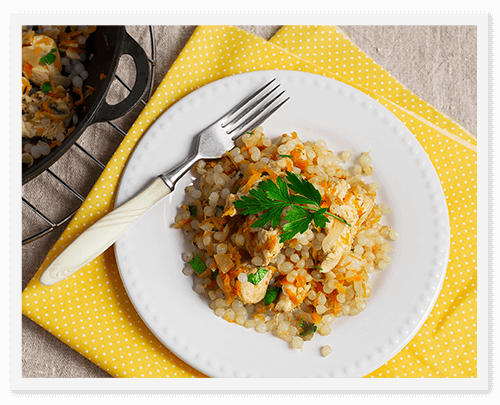It’s hard to get away from eating rice – it’s a part of so many dishes.
Rice is such a common part of the diets of billions of people around the world. With many eating it daily.
But is it that bad for you?
Well we do know that it’s also a plant-based food so it HAS to offer health benefits, right?
But of course, we strip some of those out when we refine brown rice into white rice.
The RICE debate has been raging for decades …
Questions like…
In this article, we will answer all those BURNING QUESTIONS… So you are left with NO DOUBT.
Plus, I’ll give you my top 5 rice alternatives (that lower your blood sugar)
So what about WHITE RICE?
You have likely heard it may not be good for you…
But is that true?
Well a high glycemic index is 70 or above (and doctors recommend you eat foods that are less than that figure diabetes or not)
White rice has a score of 73. So a little over the threshold
That’s partly because the FIBER is removed, along with many nutrients, when brown rice is refined to become white rice.
The outside layers are stripped away, taking the B vitamins, minerals, fiber, and antioxidants.
And because white rice doesn’t have the fiber, it digests much faster, quickly SPIKING BLOOD SUGAR LEVELS.
Essentially, we took a healthy product like whole grain brown rice and cut away the healthy parts.
Alright then so we know we should AVOID white rice . . .
Which means to eat brown rice, right?
Well, not so fast. We should look more closely at brown rice before making assumptions and our decisions.
Brown rice has a glycemic index score of 68 . . . which is NOT that much lower than white rice. But just under the DR’s recommendations…
And unlike white rice, BROWN rice is a whole grain that still has a bunch of NUTRIENTS that are great for our bodies…
That means brown rice has many more health benefits, including antioxidants, vitamins and minerals, and fiber.
One cup of brown rice has 86% of the manganese you need in a day.
And thanks to all that fiber, brown rice will help reduce post-meal blood
In an 8 week-long study, adults with type 2 Diabetes that ate brown rice 10 times per week saw BIG improvements in blood sugar levels, and even in endothelial function which measures heart health.
ANOTHER SURPRISE: Eating brown rice helps you LOSE weight…
A study followed 40 overweight or obese women for 6 weeks while they ate 3/4 cups of brown rice each day.
The women lost weight, inches from their waist, and lowered their body mass index.
That’s pretty amazing!
But remember, weight loss happens when we REPLACE an unhealthy food choice with a better one . . .
AND watch portion sizes. (This is one of the biggest mistakes in the western diet)
Anyway… to reduce the overall glycemic index of your meal, it’s good to eat brown rice with protein, healthy fats, and other low glycemic index foods.
Also, make sure your brown rice is LONG GRAIN brown rice for maximum health benefits.
So brown rice and Brown Basmati Rice) seem like a decent choice for diabetics…
But let’s go a step further…
An even better version is BROWN BASMATI RICE… which has a lower glycemic index And it also is a prebiotic…
So it helps your gut health by increasing the good, or friendly, bacteria.
Plus it is packed full of vitamin b and the minerals copper and magnesium—and magnesium helps balance blood sugar levels!!!
Plus it is packed full of vitamin b and the minerals copper and magnesium—and magnesium helps balance blood sugar levels!!!
If you’re not familiar with basmati rice, “basmati” is a Hindi word for fragrant.
You’ll see why . . . or SMELL why . . . when you open a bag of basmati rice.
It’s easy to find in your grocery store and can be used in most recipes calling for rice.
We now know that including rice in your diet as a diabetic, you should STICK TO wholegrain basmati and brown rice, and watch your portion sizes.
Of course, you can get more HEALTH BENEFITS and balance your blood sugar EVEN better when you SUBSTITUTE other foods for rice…
Which is great because I don’t fancy eating rice every day? And you may not either…
So I also want to give you my top 5 scrumptious and filling rice alternatives.
They are…
Did you know Quinoa isn’t a grain? It’s actually a relative to spinach! But in this case, we cook the seed and use it similar to rice.
That means it’s GLUTEN-FREE in case you’re sensitive.
It’s also a complete protein with ALL 9 of the essential amino acids – these are essential because we can’t make them; we have to eat them.
Quinoa is low in carbs while being high in protein and fiber – that’s a good mix for Diabetics.

That protein makes this a great rice alternative for WEIGHT LOSS because the protein will digest more slowly.
You’re also getting B vitamins, magnesium, and antioxidants.
So while quinoa has carbs and a GI of 53, it’s still better than rice for blood sugar levels and weight loss.
Let’s move down the list to another rice alternative – this one is even lower on the glycemic index.
Freekeh is a whole grain that comes from wheat harvested while it’s still green. So this one does contain gluten.
It’s roasted or smoked while in the grain form and then the shells are removed.
After that, you can cook it similarly to rice by boiling it with one part freekeh and two parts water.
Freekeh has a glycemic index of 43, which is well into the low GI range, and it’s RICH IN PROTEIN AND FIBRE

A small, 1/4-cup serving gives you 8 grams of protein and a whopping 4 grams of fiber.
That same serving size also gives you 8% of your daily iron needs.
Freekeh can even help you BUILD MUSCLE with its glutamic acid – which is something bodybuilders add to their diet to help their body make glutamine.
Here we have another grain known for its chewy texture. This one originated in Mesopotamia.
The name farro is Italian for ancient wheat grain, and it actually includes 3 types:
Einkorn, Emmer, and Spelt.
The middle one, Emmer, is the type you’ll find in Europe and the US.
Farro is a good source of fiber, protein, magnesium, zinc, and B vitamins.

Let’s look at a 1/4 cup serving size again. You’ll get 6 grams of protein and 5 grams of fiber.
Additionally, farro has polyphenols, carotenoids, and selenium, and a diet rich in these PROTECTS AGAINST some cancers, diabetes, heart disease, and brain diseases.
Now we’ve looked at a seed – Quinoa – and two grains that make good rice substitutes while being fairly low on the glycemic index scale.
This next one is a bit different . . .
This one is new and old – the noodles have been around for a very long time while the rice product is somewhat new to the market.
Shirataki rice is made from a Japanese tuber called Konyaku, which has Glucomannan starch.
This starch is extracted and mixed with water to make konnyaku, and this is shredded to make traditional shirataki noodles . . . and now rice.
This “rice” is vegan and gluten-free so more people can eat shiraktaki rice . . . but unfortunately it’s also fairly nutrient-free as well.

The reason it made it to #2 on the list is that shirataki rice has LITTLE TO NO CALORIES per serving because glucomannan starch is an indigestible dietary fiber and also contains no carbohydrates.
So if you are on a stricter diet and working to lose weight, this is the option for you.
Of course, our #1 rice substitute is also low carb and low calorie, and very easy to find.
This vegetable might not make it onto your list of veggies that you eat regularly.
Some people mistakenly think that because it’s white, it doesn’t have the same health benefits as brightly colored vegetables like broccoli or carrots.
Normally, it’s good to eat a variety of colors in your natural food choices, but cauliflower breaks the rule.
It’s actually a good source of vitamin C and fiber . . . AND you find cauliflower in orange, yellow, and purple varieties that have more nutrition from the natural color.

It’s actually a GREAT SOURCE of vitamin C and fiber . . . AND you find cauliflower in orange, yellow, and purple varieties that have more nutrition from the natural color.
Cauliflower rice is simply finely crumbled florets, so it’s easy to make at home or buy premade in the frozen vegetable section.
As a vegetable, it’s not as filling as the grain alternatives we listed, but that means you can eat more while still consuming fewer calories.
This rice alternative is another great choice for weight loss because half a cup has only 14 calories and 3 grams of carbs.
And for one last idea, you might try mixing one of these with brown rice.
Cauliflower rice and brown rice – or brown basmati rice – can give you the BEST OF BOTH WORLDS as you’re getting a vegetable and the health benefits of brown rice.
Also, cauliflower isn’t the only vegetable that can replace rice – try chopped up and cooked cabbage or even broccoli if you want to pack in the nutrients. And it’s a great way to make veggies fun.
So now you know the truth about brown and basmati rice . . . and have FIVE wholesome heart-healthy alternatives to rice.
This gives you options to enjoy rice dishes while keeping your blood sugar under control AND losing weight!
while these nutritious options are will help keep your body fit, healthy, and strong, And will go a long way to COUNTERING your diabetes
They are just a start…
But don’t worry because the AMAZING news is that balancing and correctly maintaining blood sugar - And FIGHTING the threat of diabetes -
Is SIMPLER than most people imagine.
On the NEXT PAGE I have put together an all-star team of Doctors, Nutritionists, and Diabetes researchers from all over the world that’ll help you do just that Plus, they’ll REVEAL…
How to find an ABUNDANCE of SATISFYING foods, herbs, spices and a range of delicious alternatives that..
On the next page I have put together an all-star team of Doctors, Nutritionists, and Diabetes researchers from all over the world that’ll help you do just that Plus, they’ll REVEAL...
